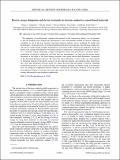Electric energy dissipation and electric tortuosity in electron conductive cement-based materials
Author(s)
Soliman, Nancy A; Chanut, Nicolas; Deman, Vincent; Lallas, Zoe; Ulm, Franz-Josef
DownloadPublished version (1.154Mb)
Publisher Policy
Publisher Policy
Article is made available in accordance with the publisher's policy and may be subject to US copyright law. Please refer to the publisher's site for terms of use.
Terms of use
Metadata
Show full item recordAbstract
© 2020 American Physical Society. The emergence of multifunctional cement-based materials in the construction industry has the potential to shift the paradigm from strength-only performance to new functionalities enabled by electron conducting capabilities in one of the most material- and energy-intensive industry sectors worldwide. To enable such developments, we present results of a hybrid experimental-theoretical investigation of the electrical conductivity and resistive (Joule) heating of highly heterogeneous nanocarbon (nCB)-cement-based composites (pastes and mortars). By analogy with diffusivity, we find that electrical conductivity is determined by the electric tortuosity of a "volumetric wiring"permeating a highly heterogeneous matrix from percolation to saturation. From a combination of electrical conductivity and Joule heat rate measurements, we show that the electric energy dissipation at the origin of the Joule heating originates from spatial electric-field fluctuations, reminiscent of the fluctuation-dissipation theorem. We report that these fluctuations - in first order - are well captured by functional relations of the electric tortuosity of the composite material, and synthesize these observations into a first-order dissipation-tortuosity model. We suggest that harvesting the benefits of electron conducting cement-based materials, such as resistive heating, electromagnetic shielding, and energy storage, will ultimately focus on settling the competition between conductor concentration and electric tortuosity. Given the global environmental footprint of concrete, the results open venues for the sustainable development of concrete for existing and emerging green technology applications.
Date issued
2020-12Department
Massachusetts Institute of Technology. Department of Civil and Environmental Engineering; MIT Energy Initiative; MultiScale Materials Science for Energy and Environment, Joint MIT-CNRS LaboratoryJournal
Physical Review Materials
Publisher
American Physical Society (APS)
Citation
Nancy A. Soliman, Nicolas Chanut, Vincent Deman, Zoe Lallas, and Franz-Josef Ulm, Electric energy dissipation and electric tortuosity in electron conductive cement-based materials, Phys. Rev. Materials 4, 125401
Version: Final published version
ISSN
2475-9953